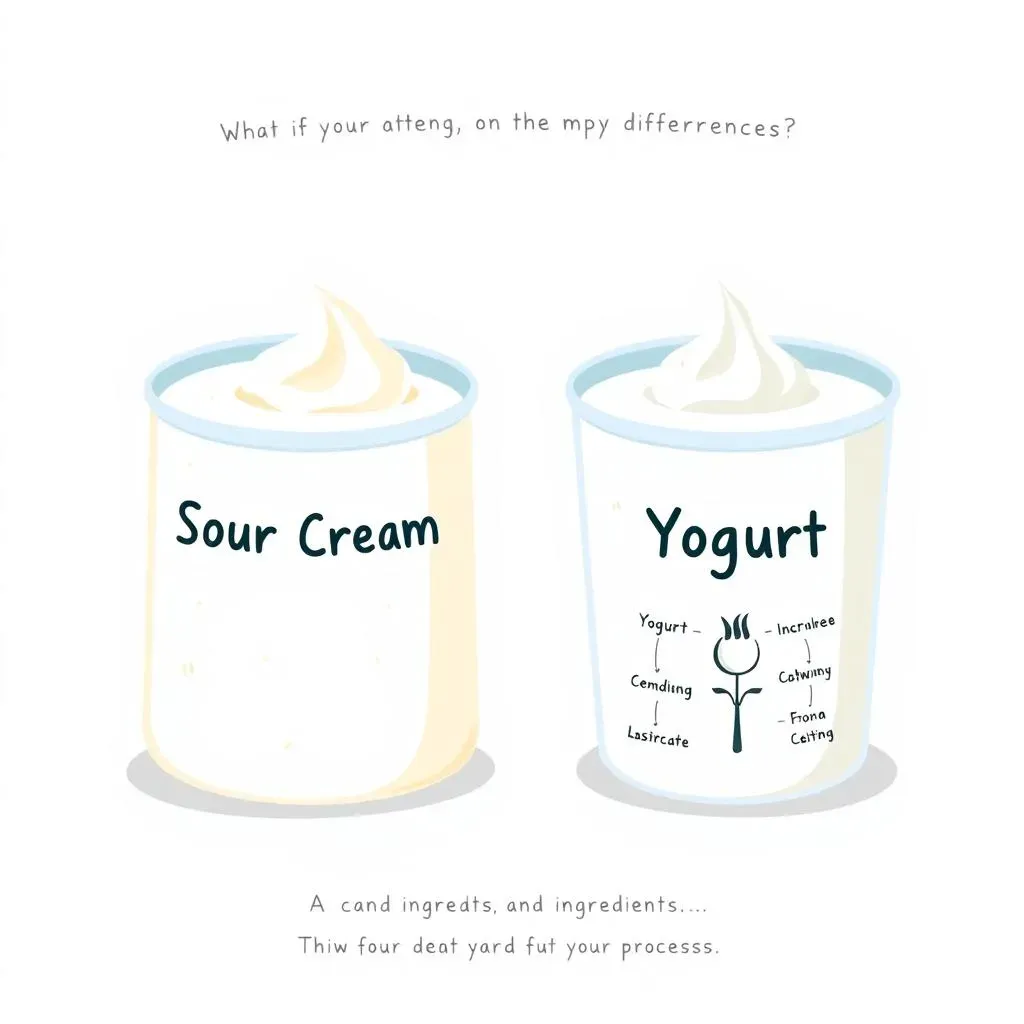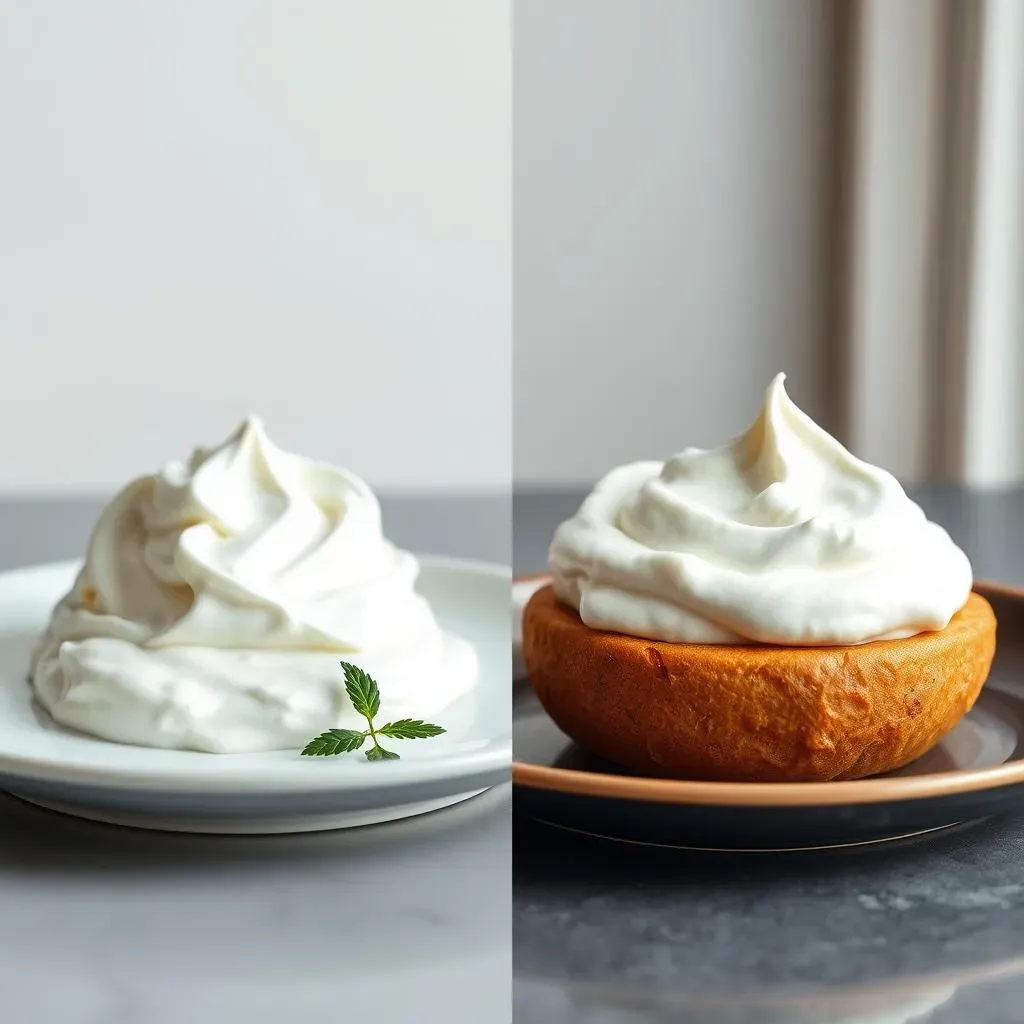Table of Contents
Ever found yourself in the middle of a recipe, only to realize you're out of sour cream? I've been there, and it's a real kitchen bummer. But what if I told you that your fridge might hold the answer? Yes, I'm talking about yogurt! The big question is: can you substitute yogurt for sour cream? It's a common kitchen conundrum, and I'm here to untangle it for you. In this article, we'll explore the ins and outs of using yogurt as a stand-in for sour cream. We'll look at how they compare in taste and texture, and I will show you the best methods to make the swap, whether you're baking a cake or whipping up a tangy dip. We'll also talk about some health benefits and potential pitfalls of making this switch. Get ready to become a yogurt-substituting pro; it's easier than you think, and it might just save your next culinary creation!
Can You Substitute Yogurt for Sour Cream? Understanding the Basics

Can You Substitute Yogurt for Sour Cream? Understanding the Basics
Okay, so let's get real. Sour cream and yogurt, they're both creamy, tangy, and often hang out in the dairy section, but they're not exactly the same. Sour cream is, well, cream that's been soured, giving it that rich, thick texture and distinct tang. Yogurt, on the other hand, is made from milk fermented with live cultures. This process gives it a similar tanginess but a slightly different consistency. When you're staring into your fridge, wondering if you can swap one for the other, it's not a simple yes or no. It's more like, "it depends." Both have their own unique properties. However, understanding the core differences can help you decide when and how to make the switch. Think of it like this, they are cousins, they look similar, but they have their own unique personality.
How to Substitute Yogurt for Sour Cream in Baking and Cooking

How to Substitute Yogurt for Sour Cream in Baking and Cooking
Baking with Yogurt: A Smart Swap
Okay, so you're ready to bake, but the sour cream is MIA. No sweat! Yogurt, especially Greek yogurt, can be a fantastic substitute in most baking recipes. The key is to understand the moisture difference. Yogurt is generally thinner than sour cream, so you might need to adjust the liquid in your recipe slightly. For instance, if a recipe calls for a cup of sour cream, try using a cup of full-fat Greek yogurt. If the batter looks a bit too thick, add a tablespoon or two of milk or water until you get the desired consistency. This little tweak ensures your baked goods stay moist and delicious, not dry and crumbly. Remember, baking is a science, and sometimes a tiny adjustment can make all the difference.
I've used yogurt in everything from banana bread to coffee cake, and the results are usually amazing. The slight tanginess of the yogurt actually enhances the flavors of the other ingredients, giving your baked goods a more complex taste. Just be mindful that yogurt can sometimes be a bit more acidic than sour cream, so if your recipe relies heavily on baking soda, you might want to add a tiny pinch of baking powder to balance things out. This will prevent any weird aftertastes. It's all about experimenting and finding what works best for your taste buds. Think of it as a fun, delicious science experiment.
Ingredient | Sour Cream | Yogurt Substitute | Notes |
|---|---|---|---|
Moisture | Thick, creamy | Thinner, varies | May need liquid adjustment |
Tanginess | Distinct tang | Slightly different tang | Can enhance flavors |
Acidity | Moderate | Slightly higher | Adjust baking soda if needed |
Cooking with Yogurt: A Tangy Twist
Now, let's talk about cooking. Using yogurt instead of sour cream in savory dishes is a game-changer. Think creamy soups, tangy sauces, and flavorful dips. The trick here is to add the yogurt at the end of the cooking process, especially if it's a hot dish. If you boil yogurt, it can curdle, which is not what you want. Instead, take your pot off the heat, let it cool slightly, and then gently stir in the yogurt. The heat will warm it through without causing it to separate. This is how you maintain that smooth, creamy texture we’re all after.
I love using yogurt in place of sour cream in things like chili, tacos, and even mashed potatoes. It adds a wonderful tanginess that cuts through richness, making the dish feel lighter and more vibrant. It's also a great way to sneak in some extra protein and probiotics. For dips, like a classic French onion, yogurt is a great swap. Just make sure you use a thick yogurt like Greek, so you get that same satisfying scoop. Remember, cooking with yogurt is all about being mindful of temperature and timing. Get those right, and you'll be a yogurt-substituting wizard in no time.
Yogurt vs. Sour Cream: Taste, Texture, and Health Differences

Yogurt vs. Sour Cream: Taste, Texture, and Health Differences
Taste and Texture Showdown
Okay, let's talk about the fun stuff: taste and texture! Sour cream, as I've mentioned, has this rich, almost decadent tang. It's smooth, thick, and coats your mouth in a way that's both satisfying and a little indulgent. Yogurt, on the other hand, has a brighter, cleaner tang. The texture can vary widely from the thin, runny kind to the thick, spoon-standing Greek variety. When you're deciding between the two, think about what kind of experience you're going for. If you want something that feels a bit more luxurious, sour cream is your go-to. But if you're looking for a lighter, fresher tang, yogurt is the way to go. It's like choosing between a velvet blanket and a crisp cotton sheet; both are great, just different.
I've noticed that the fat content also plays a huge role in how these two feel in your mouth. Full-fat sour cream is, well, full of fat, which gives it that extra-richness. Yogurt, especially non-fat or low-fat versions, is much lighter. But don't let that fool you, even low-fat Greek yogurt can still have that satisfying creaminess. The key is to understand the role fat plays in texture, and choose the type that best suits your recipe. Sometimes, a little extra richness is what you need; other times, a lighter touch is better. And don't forget that the specific cultures used in yogurt production can also affect its tang, so play around with different brands to find your favorite. It’s all about personal preference, really.
Feature | Sour Cream | Yogurt |
|---|---|---|
Taste | Rich, Decadent Tang | Bright, Clean Tang |
Texture | Smooth, Thick | Varies, can be thin or thick |
Fat Content | Typically high | Varies, low-fat to full-fat |
Health Benefits: A Closer Look
Now, let's get to the good stuff – the health benefits! Yogurt is often touted as a health food, and for good reason. It's packed with probiotics, those beneficial bacteria that are great for your gut. These little guys can help with digestion, boost your immune system, and even improve your mood. Yogurt is also a good source of protein, calcium, and various vitamins. Sour cream, while tasty, doesn't quite measure up in the health department. It tends to be higher in fat and calories and doesn't have the same probiotic punch. That doesn't mean sour cream is the enemy, but if you're looking for a healthier option, yogurt is the clear winner.
I always try to opt for yogurt when I can, just because I know I'm getting those added benefits. I've found that it's easier to make healthier choices if they also taste good, and yogurt definitely fits that bill. When you choose yogurt, pay attention to the label. Some yogurts can be loaded with added sugars, which can negate some of the health benefits. Plain, unsweetened yogurt is usually the best choice. You can always add your own sweeteners like honey or fruit, so you know exactly what you're getting. It's all about making informed choices, and understanding the nutritional value of what you're eating. It is like a small win, in every meal.
Making the Switch: Tips for Substituting Yogurt for Sour Cream Successfully

Making the Switch: Tips for Substituting Yogurt for Sour Cream Successfully
Choosing the Right Yogurt
Alright, so you're ready to swap yogurt for sour cream, but not all yogurts are created equal. The type of yogurt you choose can make a big difference in the final result. For most recipes, especially baking, I highly recommend going with full-fat Greek yogurt. It's thicker and creamier than regular yogurt, which makes it a better stand-in for sour cream. The higher fat content also helps mimic the richness of sour cream. If you’re watching your fat intake, low-fat Greek yogurt can also work, but you might need to add a little extra moisture to compensate. Avoid using non-fat yogurt, it might be too watery and affect the texture of your dish. Remember, the goal is to get as close to the texture and richness of sour cream as possible, so choose wisely.
For savory dishes and dips, I often use whole milk yogurt, especially if I want a lighter tang. It's less thick than Greek yogurt, but it still brings that wonderful creamy texture. If you're using regular yogurt, you can strain it through a cheesecloth for a few hours to remove some of the excess water, making it thicker. This step is kind of like making your own Greek yogurt. Don't overthink it, experiment with what you have on hand, and see what works best for your taste preferences. It’s all about finding what you like and what works best for your recipe. Remember, the kitchen is your playground, so don't be afraid to experiment.
Adjusting for Texture and Flavor
Now, let's talk about adjusting the texture and flavor. As I mentioned earlier, yogurt is generally thinner than sour cream, so you might need to make a few tweaks to get the consistency just right. If your recipe is too runny, you can add a thickening agent, like a tablespoon of cornstarch or arrowroot powder. Mix it with a little cold water to form a slurry before adding it to your dish. This will help prevent clumps and give you that smooth, creamy texture you're looking for. If you’re using a thin yogurt, you can also try adding a tablespoon of heavy cream or even a bit of cream cheese to boost the richness. It’s all about playing with the balance, and finding what suits you best.
Taste-wise, yogurt is tangier than sour cream, so you might want to add a pinch of salt or a little bit of lemon juice to mimic the flavor of sour cream. The amount you add will depend on your personal preference and the recipe you're making. Start with a small amount and taste as you go. It's always easier to add more than to take away. Remember, cooking is an art, not a perfect science. Trust your taste buds, and don't be afraid to make adjustments as you go. It's all part of the fun and the learning process.
Aspect | Tips for Success |
|---|---|
Yogurt Type | Use full-fat Greek for baking, whole milk for savory dishes |
Texture Adjustment | Thicken with cornstarch or arrowroot, add cream for richness |
Flavor Adjustment | Add salt or lemon juice to mimic sour cream tang |